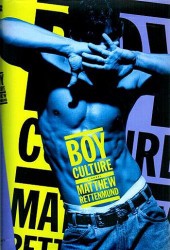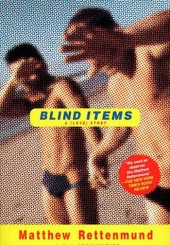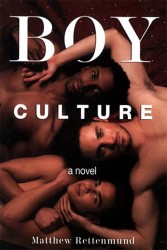 Boy Culture / Blind Items
Boy Culture / Blind Items
by Matthew Rettenmund
Published by St. Martin’s Press
Published September 1995 / August 1998
Fiction (humor)
192 pgs. / 288 pgs.
Reviewed by Stephen O. Murray
March 25, 2001.
Matthew Rettenmund’s 1995 first novel, Boy Culture, begun as a University of Chicago student, was very funny and smart(-assed).
Its hustler narrator was comically unable to seduce his roommate and oddly credulous about what a client told him about events of sixty years earlier. (The mix of a present-day narrator quite aware of his limitations and a connection to a seemingly more romantic past brings Alan Hollinghurst’s superb The Swimming-Pool Library to mind.)
I thought the narrator, X, was suspiciously analytical, though I enjoyed his (bratty) voice. I thought his reaction to finding out that he’d been spun a (manifestly pornographic) tale by his octogenarian client Gregory was not only excessive but out of character. Why get so upset about a fictional delusion about what happened 60+ years ago? Even its invention was a means to winning X, so it seems more a tribute than an affront. Okay, so X has trouble trusting people, and Gregory is someone he trusted. But he was being paid to serve Gregory’s fantasies, no?
Hollinghurst’s second novel also kept me up late finishing reading it. Blind Items is often very funny, and it has another connection that involves reconstructing a distant past, this time to a gay silent movie star, most of whose movies are supposedly lost.
 Blind Items has two main narrative lines and a collection of semi-fictional gossip columns that sneer at closeted gay actors, some of whom are named, some of whom are identified by circumlocutions such as “a young actor playing a doctor in a tv soap opera.”
Blind Items has two main narrative lines and a collection of semi-fictional gossip columns that sneer at closeted gay actors, some of whom are named, some of whom are identified by circumlocutions such as “a young actor playing a doctor in a tv soap opera.”
David Greer works for a magazine about gay porn films and their “stars.” Warren Junior, David’s best friend, is a black (on the outside) gossip columnist for a New York weekly paper. Using an invitation Warren was going to throw out, David and his “gal pal” Carol go to a party where David flirts with and is flirted with by hunky Alan Dillinger, who plays a lifeguard on a popular television series.
They don’t lack in chemistry, but Alan’s burgeoning career as a heartthrob provides strong pressure to remain closeted. David is not notably political but does not want to be in a relationship that involves skulking about. I guess that I should not spoil the plot and reveal whether there is real tinsel beneath the false tinsel, or the proverbial heart of gold. There is, eventually, some hot sex, and a number of familiar lessons about honesty, communication, empathy.
The storylines move along with much self-deprecating wit—that’s what we do best, right? And taking inordinate interest in the trashiest pop culture verges on a stereotype of gay men. In that Rettenmund is the author of Totally Awesome 80s and the Encyclopedia Madonnica, the fascination of David and Warren for the silliest detritus of the entertainment industry is probably autobiographical.

St. Martin’s Griffin, Jan 2007
The secondary storyline may also be autobiographical. It deals with an overweight and alienated teenager living with a tyrannical grandmother. John Dewey (!) develops a fascination with silent films and nearly forgotten leading man Gil Romano. He gets in touch with an aged photographer who may have Romano’s lost masterpiece.
I enjoyed the novel while I was reading it, but trying to make a case for it a few days after reading it is difficult. It is like a pastry: not nutritious or filling, but pleasant as it goes down, then quickly forgotten. It is not going to supplant The Swimming-Pool Library in anyone’s memory. Or even eclipse My Worst Date.
Although Rettenmund avoided the “sophomore jinx,” he has not published a third novel, alas. Boy Culture was made into a movie I liked a lot. Read about it here.
©2001, 2016, Stephen O. Murray
mostly published on AssociatedContent 25 March 2001.

